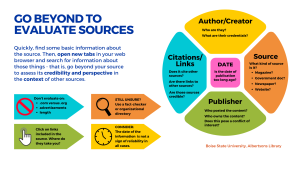2 Evaluating Sources

WEEK 2: EVALUATING SOURCES
This week we’ll be strengthening our ability to evaluate information, and using what we learned to review and create resources for our community. There are 2 parts in this module. It’s estimated you’ll need up to 6 hours to complete all of the assignments in this module.
Part 1 of 2 – LATERAL READING
Objectives:
- Update our understanding of the latest information literacy theories and techniques.
- Practice fact checking.
- Connect these concepts to our goals as information literacy influencers.
Activities:
1. (30 min) Watch the video Sort Fact from Fiction and then answer the questions below
-
-
- Was this new information for you? How so? If not, how have you learned about these concepts before?
-
2. (60 min) Read the article What Fact Checkers Know About Media Literacy – And Students Should, Too. Then answer the questions below.
-
-
- What were your main takeaways from this article?
- How might we use this information to start creating materials to help our communities change their online information habits?
-
3. (45 min) Practice lateral reading with a brief tutorial from University of Arizona Library How Do I Evaluate Online Information. Click on the link to access the tutorial. When you’ve completed the course answer the following questions:
-
-
-
- What are your main takeaways from this brief tutorial?
- How does the tutorial relate to the video and article you reviewed in Assignments 1 and 2?
- How would you rate the tutorial? Why?
-
-
4. (30 min) Many libraries continue to teach the CRAAP test as a kind of checklist for evaluating information as in this How To Spot Fake News Infographic. Albertsons Library has switched, updating their instructional materials to teach Lateral Reading as a means to identify false and misleading information. The infographic below gives you an overview of Lateral Reading.

Compare the How to Spot Fake News infographic with the Go Beyond to Evaluate Sources infographic above and answer the following questions.
-
-
-
- What are the key differences between the two infographics?
- How might the updated infographic guide information users to determine where information comes from? Why is that important?
- How would you describe the updated infographic to a friend?
-
-
Part 2 of 2 – REVIEW & CREATE
Objectives:
- Review resources related to information literacy education.
- Create a social media resource related to what you’ve learned this week.
Activities:
- (90 minutes) Go to the library guide – Disinfo Debunking Station. Click on the “How to Debunk It” tab. This page contains a curated collection of resources to help people deal with false and misleading information online. Check out at least 2 resources, then write a brief review of each resource including some initial thoughts on how we might use or adapt it for a lesson or social media post.
-
- Resource 1:
- Resource 2:
-
2. (60 minutes) Create a social media post (choose 1 of the following):
- Create a short reel (60 seconds or less) for Instagram or Facebook related to what you’ve learned this week. Submit a link to the reel rather than the reel itself.
- OR write a brief blog post (1-2 paragraphs) to help your peers better understand the issues we learned about this week. Include an image to be used with the post.
- OR create a series of 3 posts with images and wording for Facebook or Instagram. Include the hashtag #DisinfoSquad in your creation.
PRO TIPS:
– Include captioning on reels that have no type.
– Link to one of the resources you’ve used in the course or on the Disinfo Debunking guide

